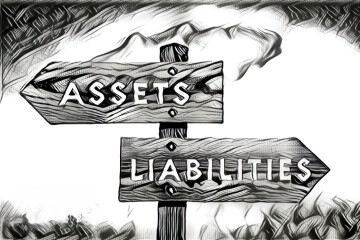Lesson 9: Assets and Liabilities
In this lesson, we will delve into a fundamental concept that lays the foundation for financial success: understanding assets and liabilities. As you embark on your financial journey, grasping the distinction between these two essential components is crucial in making informed decisions about managing your money and building wealth.
What are Assets?
In the realm of personal finance, assets are valuable resources or possessions that have economic value and can be converted into cash. Assets contribute to your net worth and can be instrumental in achieving financial security and prosperity. Assets can take various forms, and understanding the different types is vital for effective financial planning.
Types of Assets:
- Cash: Physical currency and money in bank accounts.
- Stocks: Ownership in a company, entitling the holder to a share of its profits and assets.
- Bonds: Debt securities representing loans made to governments or corporations.
- Real Estate: Property, land, and buildings.
- Precious Metals: Gold, silver, and other valuable metals.
- Commodities: Natural resources such as oil, natural gas, or agricultural products.
- Personal Assets: Personal assets include possessions and valuables that you own for personal use and enjoyment. These can range from your car and furniture to jewelry and electronics.
- Intellectual Property: Intellectual property assets include patents, trademarks, copyrights, and trade secrets. These assets provide exclusive rights and can have significant value for businesses and creators.
What are Liabilities?
Liabilities, on the other hand, represent financial obligations and debts that you owe to others. Unlike assets, liabilities reduce your net worth and can impact your financial stability. Managing liabilities is crucial to avoid excessive debt and maintain a healthy financial position.
Types of Liabilities:
- Consumer Debt: Consumer debt includes credit card debt, personal loans, and any other debts incurred for personal expenses. High-interest consumer debt can quickly accumulate and become a financial burden.
- Mortgages: A mortgage is a long-term loan taken to purchase a home or real estate property. It is one of the most common and significant liabilities for many individuals.
- Student Loans: Student loans are debts taken to finance education expenses. They can be a considerable burden for recent graduates, impacting their financial flexibility.
- Business Debt: Business debt includes loans and other financial obligations incurred by businesses to finance operations and expansion.
Leveraging Assets for Wealth Building:
Assets play a critical role in building wealth and achieving financial independence. Here are some ways to leverage assets effectively:
- Investing in Income-Generating Assets: Consider investing in assets that provide a steady stream of income, such as dividend-paying stocks, rental properties, or bonds. These assets can contribute to your cash flow and support your financial goals.
- Diversification: Diversifying your asset portfolio helps spread risk and minimize the impact of potential losses. Consider a mix of different asset types to balance potential returns and risks.
- Long-Term Investing: Patience and long-term perspective are essential when investing in assets. Over time, the power of compounding can significantly increase the value of your investments.
- Paying Off High-Interest Debts: Prioritize paying off high-interest consumer debts to reduce financial stress and free up resources for investing and wealth-building opportunities.
Managing Liabilities for Financial Stability:
Managing liabilities is equally crucial for financial stability and growth. Here are some strategies to handle liabilities effectively:
- Debt Repayment Plan: Create a debt repayment plan to systematically pay off your debts. Focus on high-interest debts first to reduce the overall interest burden.
- Avoiding Excessive Debt: Be cautious about taking on unnecessary debt, especially for non-essential purchases. Borrow only when necessary and within your means.
- Refinancing Options: Explore refinancing options to secure better interest rates on existing debts, such as mortgage refinancing or consolidating high-interest loans.
In summary, understanding the distinction between assets and liabilities is fundamental to financial literacy. Assets, with their potential for growth and income generation, can build your net worth and set you on the path to financial success. On the other hand, managing liabilities and reducing debt burden is essential for maintaining financial stability and flexibility.
By leveraging assets wisely and managing liabilities effectively, you can create a strong financial foundation for a prosperous future. Remember that financial decisions should align with your financial goals, risk tolerance, and time horizon. As you navigate your financial journey, always seek to enhance your knowledge and seek professional advice when needed to make informed choices that lead to financial prosperity.

@ayuecosystem #kids #youngadults #BuildingWealth #FinancialLiteracy #AssetsAndLiabilities #IndianFinance #FinancialPlanning #InvestingWisely #NetWorth #DebtManagement #WealthCreation #FinancialIndependence #BalanceSheet #DiversifiedPortfolio #LongTermInvesting #FinancialStability #InvestmentStrategies #AssetTypes #LiabilityManagement #FinancialEducation #DebtRepayment #SmartInvesting #IndianInvestors